If you’re planning a trip to River Street and are interested in learning more about Black history in Savannah, I highly recommend stopping by the African American Monument.
It was the first monument in the entire city erected to honor African Americans, and — believe it or not — that didn’t even happen until the early 2000s. (Savannah’s a little behind the times in these types of initiatives — although we’re doing better than many Southern cities.)
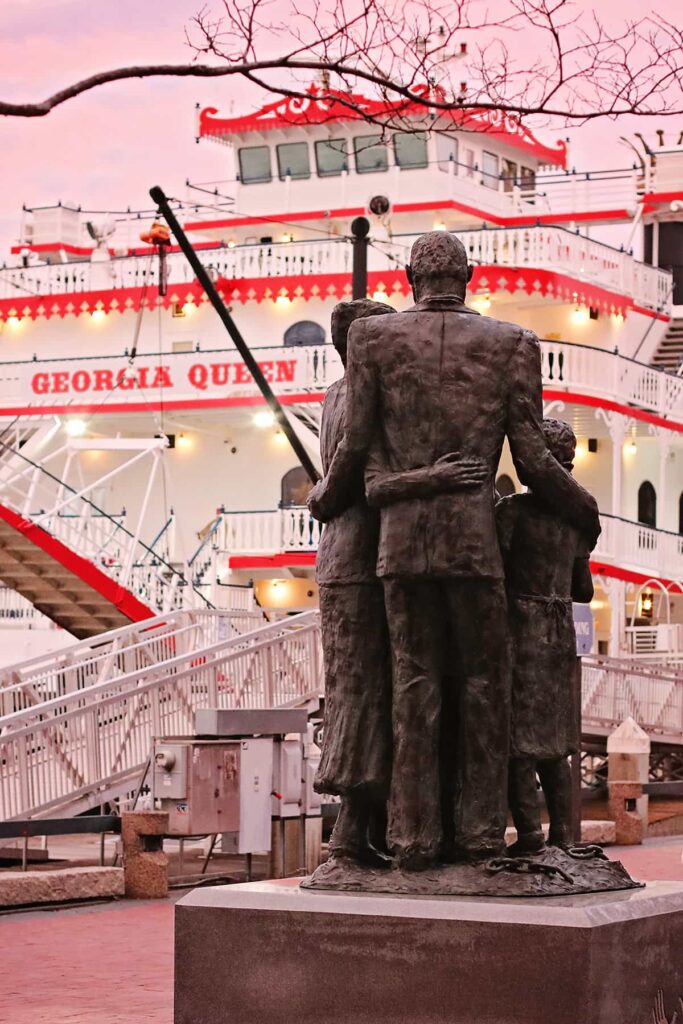
Note: This guide contains affiliate links to my trusted travel partners.
Table of Contents
African American Monument Savannah
The monument depicts a family of four that has been newly emancipated from the confines of slavery. Broken chains at their feet symbolize newly gained freedom. They’re gathered together closely, with each family member protectively touching another.
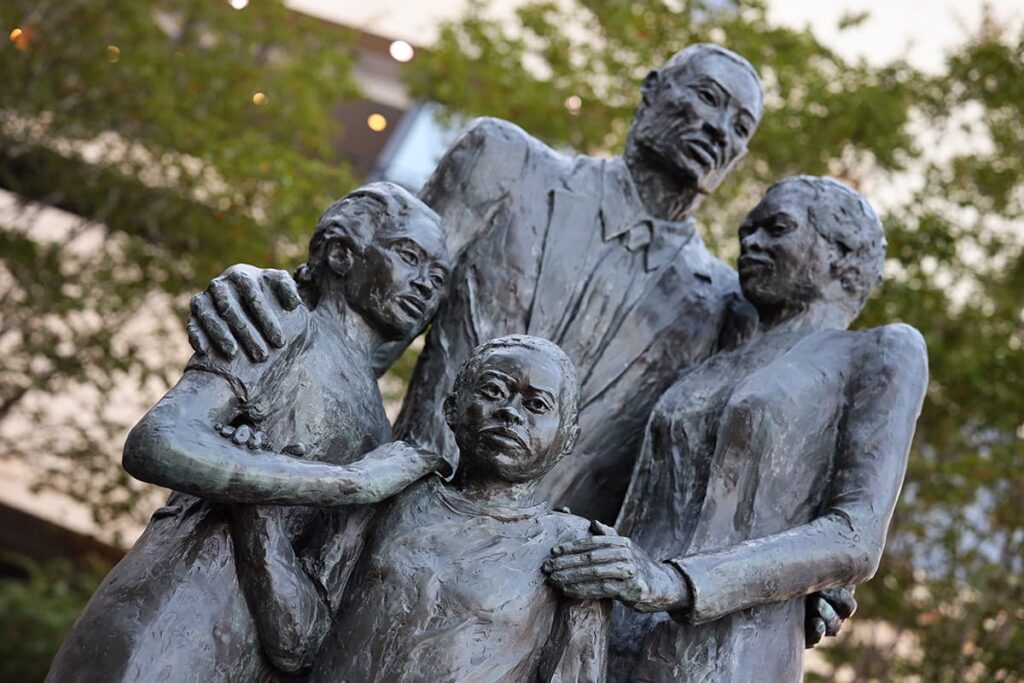
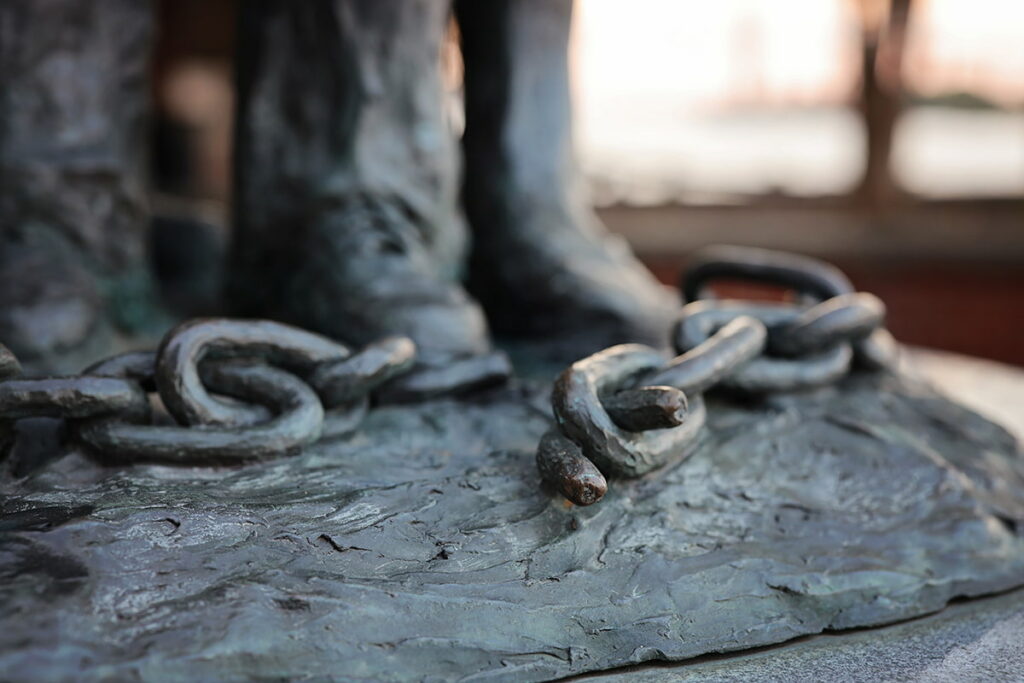
If you’re interested in visiting the monument with a guide, allow me to suggest Sistah Patt’s tour. She’s a native Savannahian and a direct descendent of the Gullah Geechee families who were enslaved in this area.
Thank you for supporting local guides! 💛
Controversy over the Maya Angelou Quote
As with most things in Savannah, there’s a story behind the inscription on the monument.
The quote is by Maya Angelou, but it stirred up quite a bit of debate amongst city leaders before it was finally approved.
Many of the city’s stakeholders thought the message was too polarizing — especially considering the statue’s prime waterfront location in one of the most popular areas of the city. (Tourism is a multibillion-dollar business in Savannah!)
Savannah’s first Black mayor even spoke out against the inscription by claiming he thought it was too divisive.
The quote does paint quite a vivid picture of the horrors enslaved men and women endured during the Middle Passage.
See for yourself…
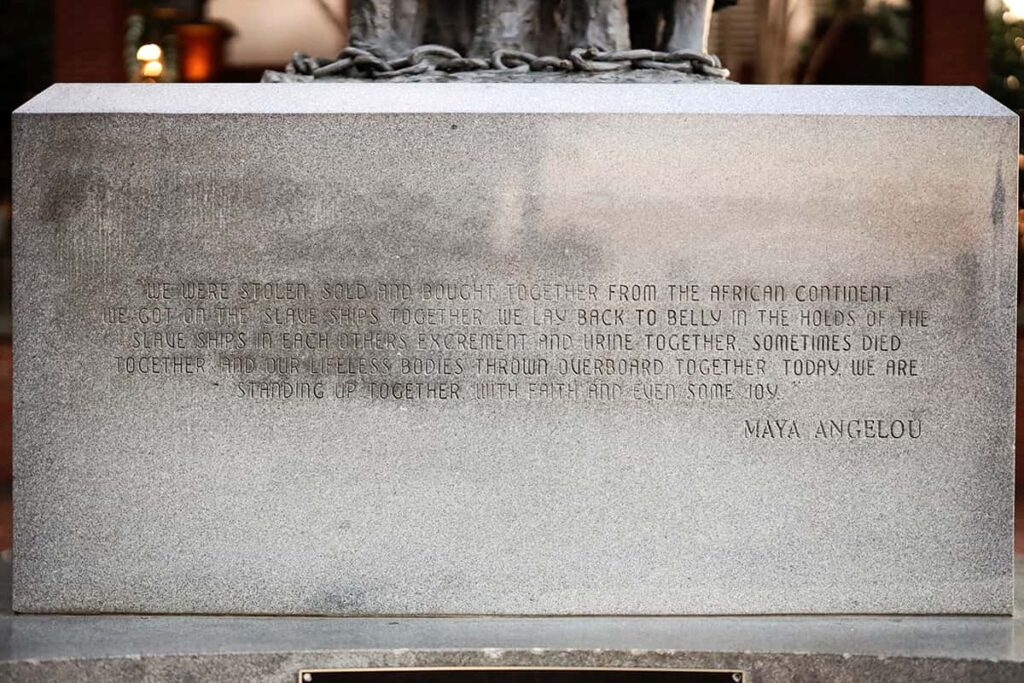
Here is Maya Angelou’s quote, in its entirety:
We were stolen, sold and bought together from the African continent. We got on the slave ships together, we lay back to belly in the holds of the slave ships in each others excrement and urine together. Sometimes died together and our lifeless bodies thrown overboard together. Today, we are standing up together, with faith and even some joy.
Maya Angelou, inscription on the African American Monument in Savannah, GA
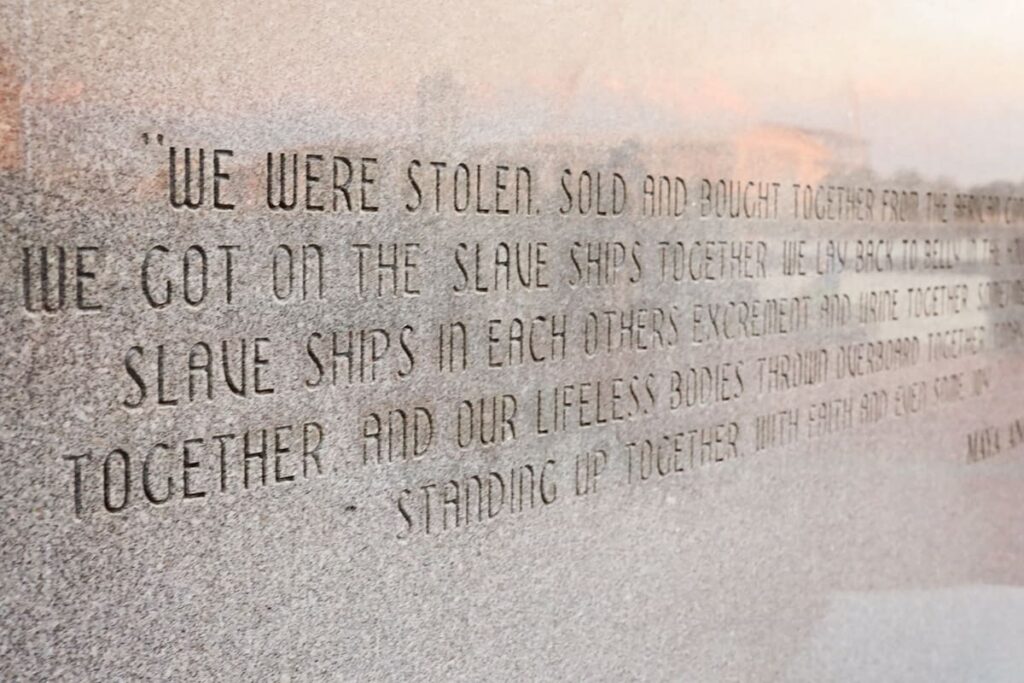
In order to get the inscription approved, Maya Angelou had to amend the quote by adding the bolded line at the end. After the insertion of that uplifting closing sentence, City Council members finally conceded to having monument placed along River Street.
Adding a Plaque to Recognize “Dr. Abbie”
In addition to the inscription, there’s a plaque mounted at the base of the statue that includes its dedication date, major contributors, and information about the sculptor.
Dr. Abigail H. Jordan is the person who fought hardest for the statue, and that’s why she is (so deservedly) mentioned on the plaque. She even put up nearly 100k of her own money to fund it!
The African American Monument
Dedicated July 27, 2002
In Honor Of
Dr. Abbie H. Jordan
(1925-2019)
Educator, Leader, Trailblazer and Community Activist
Dr. Jordan’s vision, tenacity, and financial contributions were the driving
force that ensured the Savannah Riverfront was the home of the first statue in
Savannah that honors African Americans. The Consortium of Doctors, Ltd.,
an organization that Dr. Jordan founded in 1991,
made significant contributions to this effort.
Sculptress: Dorothy Spradley
This plaque unveiled July 26, 2019
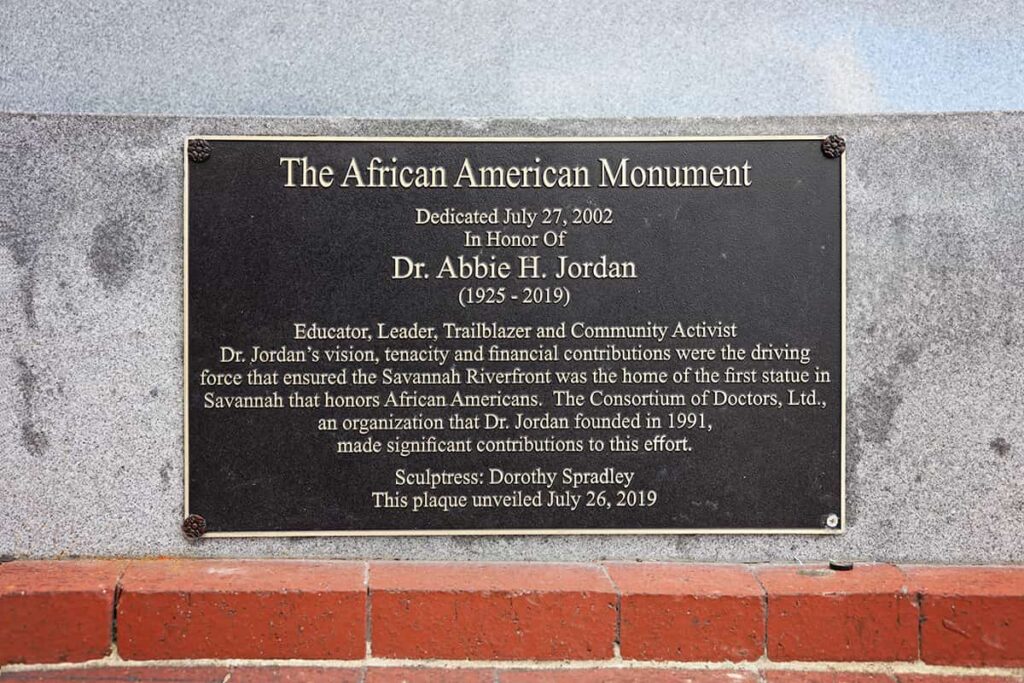
Unfortunately, Dr. Jordan passed away shortly before the plaque was officially unveiled.
The sculptress, Dorothy Radford Spradley, was an instructor at the Savannah College of Art and Design (SCAD) for many years. The choice of Spradley as the designer wasn’t without controversy, either. Some Savannahians thought a Black creator could’ve better represented spirit of the memorial.
Because of this, local Black creator James “Double Dutch” Kimble created a counterpoint to the piece that he refers to as the “Black Holocaust Memorial.” It’s located in a lane on the east side of the city’s Victorian District, and it’s one of my personal favorite hidden treasures in Savannah.
Savannah and the Slave Trade Historic Marker
If you stroll towards the river, you’ll notice there are a series of numbered educational markers lining the waterfront.
One of the markers closest to the statue has information detailing the slave trade in Savannah. It’s marker #3 with the title “Savannah and the Slave Trade.”
To briefly summarize the marker, it recalls how slavery was illegal in the early days of the Colony of Georgia and then notes that the rule was overturned in 1750 for economic reasons.
Essentially, Georgia planters wanted slaves so they could compete with the successful planters in nearby South Carolina who were producing cash crops using slave labor.
The marker also references The Weeping Time slave auction, human smuggling, and the suffering of an enslaved port worker named Olaudah Equiano.
Additionally, you can see an image of the slave manifest from the Gustavus schooner and an image of a Georgia auction house advertising “Negro sales.”
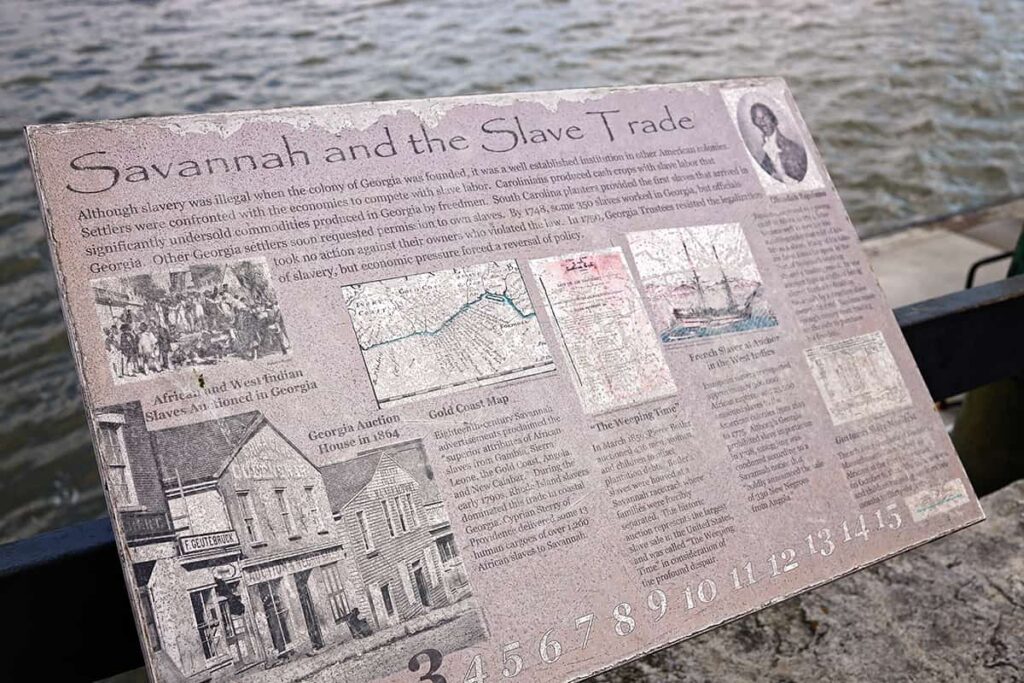
Plan Your Trip: African American Monument
Where is the African American Monument located?
Address: 1 W River Street, Savannah, GA 31401
Hours: Open year round
Restrooms: 9 a.m. – 5 p.m. at the Riverfront Hospitality Center (50 steps away)
What else is popular in the area?
Martin Luther King Jr. Bust | 0.2 miles
The Plant Riverside District | 0.2 miles
City Market Savannah | 0.3 miles
Show me more like this!
Black History Tours in Savannah: Which Ones are Best?
Savannah Travel Guide
If you’re planning to a trip to Savannah, here are a few additional resources I’ve created to help you out.
- Free Resources Library – When you sign up for my email list, you’ll get a checklist of “50 Things To Do On Foot in the Historic District (No Car Necessary)” and other helpful printables.
- Savannah First-Timer’s Guide – My ebook combines my most helpful Savannah travel tips from this website in one handy downloadable guide.
When you purchase my ebook, you’ll also gain access to a private Facebook group where you can ask questions about your trip and get advice from others who have recently visited.
